英文调查报告
英文调查报告
广告的目标
1. our main goal is to establish brand awareness among our target audience.
2. our main purpose is to establish brand awareness among our target audience.
3. the main objective is to establish brand awareness among our target audience.
本段的关键在于清楚地表明公司的目标,同时下文即可循着这个主题发展。"main goal", "main purpose", "main objective",都是指‘主要的目标'。
调查的数据
1. according to my figures, of the working women we polled, 50% said they read at least one of the top-five selling women's magazines in taiwan.
2. the numbers we have show that of the working women we polled, 50% said they read at least one of the top-five selling women's magazines in taiwan.
3. as the facts prove, of the working women who responded to our poll, 50% read one of taiwan's top-five selling women's magazines. 说明调查的结果,并作为下文结论的根据。关键词为"figures"、"numbers"和"facts"等。
依调查判断
1. if you'll take a look at this chart, the best media mix, then, would be a combination of
tv and magazine ads.
2. by looking at the chart you can see that the best media mix would be a combination of tv and magazine ads.
3. as you can tell by the chart, the best media mix would be a combination of tv and magazine ads.
根据调查结果提出方案时,通常会以图表作解释。请与会者看图表时可使用"if"句型,但它不是假设语气,而是一种客气的说法。
下结论
1. to conclude, even though our target audience is clearly defined, introducing a new product is always a gamble.
2. in summary, even though we have defined our target audience, introducing a new product is always a gamble.
3. i've shown you how to reach our target audience, yet i also think introducing a new product is always a gamble.
在最后一段可略述个人对此活动的观感,并简单扼要的下结论。"to conclude","in summary"或"i think"都是做结论的实用词汇
第二篇:英语调查报告
关于小学英语学科现状的调查报告
调查时间:20xx年x月10号—20xx年x月10号
调查地点:各乡镇小学
调查对象:全县82%左右的英语教师及各乡(镇)教研员
调查方法:座谈、听课、问卷。
调 查 人:×××
英语是世界上使用范围十分广泛的语言之一,有世界通用语之称。教育部提出在20xx年秋季开始,全国城市和县城小学逐步开设英语课程;20xx年秋季,各地乡镇小学逐步开设英语课程,小学开设英语课程的起始年级一般为三年级。我县为了提高英语教学的普及力度,适应时代发展的需要,在人力、物力和财力上加大了对英语教育的投入。但小学英语在我县毕竟是一门新兴学科,在新课程理念的指导下,走过了将近几年的历程,在这几年里,大部分教师通过努力学习,踏实工作,掌握了新的教学理念,提高了教学技能,改进了教学方法,专业素质也有了显著提升,为了了解我县小学英语的开设情况和存在的问题,确定下一步的工作中心,为进一步开展工作指明方向,我进行了将近一个月的学科调研,收获颇丰,现将成果汇报如下:
一、调查对象:
全县82%左右的英语教师及各乡(镇)教研员。
二、调查内容:
1、全县开设英语情况。
2、课时安排及班容量。
3、教师专业水平。
4、教学设备。
三、调研途径:
座谈、听课、问卷。
四、调研结果:
1、到目前为止,乡镇各村100%开设英语课程;山区有30%的乡镇,由于各村相距较远,交通不便,师资短缺而没有全面开设英语课程。这会导致小学没有学到英语的学生到了初中在英语学习方面很吃力,甚至会影响其它学科的成绩。
因此,在开设英语课方面必须“一刀切”,全面铺开。
2、课时少,间隔时间长。小学生学习英语具有模仿力强,记忆力好,勇于开口的优越条件。根据学生的这些特点,为了保证教学质量和教学效果,英语课程标准规定,3~6年级英语课程应遵循长短课时结合、高频率的原则,每周不少于四次教学活动。3、4年级以短课时为主;5、6年级长短课时相结合。但综观目前我县英语课程的开设状况可以发现:各个学校只开设长课时,绝大部分学校的周课时为2课时。课时少,间隔时间过长是我县小学英语课普遍存在的现象。此外,受地区、家庭文化氛围的影响,课外学生学习英语的意识淡薄,根据记忆规律,这种英语教学现状和英语学习状态将严重挫伤学生的学习积极性和学习兴趣,不利于形成良好的英语学习习惯。
3、部分乡镇班容量过大,影响教学质量。为了保证教学质量和效果,课程标准规定班容量一般不应超过40人每班。但部分大乡镇班容量达到60人以上,根本没有开展游戏、表演等教学活动的空间。由于受时间、空间、人数、内容量等多种因素的影响,教师无法关注每一个学生的学习情况,只能青睐于表现积极、踊跃的学生,忽略对性格内向学生的培养。造成一班中只有33%左右的学生能跟上老师的教学进度,导致部分家长认为学生在学校不能学会英语,必须参加英语学习班。
4、师资专业素质差。教师必须在岗位上不断学习、进步,我们在加大培训力度的同时,应该给他们提供继续接受教育的机会。必须高度重视小学英语教师专业素质差的现象。
5、设备差,英语氛围淡。由于我县偏远农村多,信息弊塞。小学英语的开设仍未引起部分学校和家长的重视。从教学设施方面看,拥有多媒体教室或VCD设备的学校很少,有的学校有,但在平时英语教学中也没真正应用。大部分英语教师只靠一盒磁带、一台录音机和教本上课。目前,一个小学英语老师还要身兼多门其他课程,导致教师教学负担重,英语教研气氛不浓,没有形成良好的英语教学氛围。
五、建议:
我认为,在我县小学英语教学中应特别注意以上问题。它们的妥善解决将会促进我县小学英语课程的顺利开展。
1、合理安排教学根据“课时少,间隔时间长”的现象,我们必须做到遵循
记忆规律,合理安排教学时间,做到短课时、高频率,每周不少于四次教学活动。同时要提高小学英语课程的地位,控制好小学英语课堂人数(30-40人/班)。
2、完善师资培训我县小学英语师资力量薄弱。英语培训必须完善师资培训制度,以有效解决专业英语教师断层的局面。我做为教研员应多组织小学英语教师教学研讨会、交流会、优质课的观摩活动、组织教师进行教研比拼等,从而不断提高非专业英语教师的业务水平。
3、增加教育投入为了使我县农村小学英语达到教育的目的和语言教学的目的,当地教育管理部门必须积极为英语教学创造条件。加大教育投入,例如为各校配备电视机、录音机、投影仪、光盘、磁带和教学挂图等必要设备,条件好的要逐步建立语音教室。教师要利用这些设备加大英语信息的输入量,为学生营造浓厚的英语氛围。
以上就是我的调查报告结果及建议,希望我县小学英语在我们大家的共同努力下,如芝麻开花节节高。
第三篇:调查报告范文2 (英文)
1. Introduction
Library is always a symbol of the university. It provides college students with many useful resources. At the same time, how to make full of the resources becomes a new problem for college students. For that purpose, the present survey is made.
1.1 Purpose
The survey sets its goal at investigating how well the college students can take advantage of the resources provided in our school library. Then, we hope to give some suggestions to our school library so that it can be improved in some aspects.
1.2 Subjects
In order to make the survey more persuasive, we did the research among students in our university including both undergraduates and postgraduates. 157 copies of questionnaires in total were handed out and 150 were collected back which are effective. Interviewees are from different majors and different grades. 41 of them are freshmen, 42 are sophomore, 21 are junior students, 30 are senior students and 6 are postgraduates.
1.3 Time and Place
Time: The survey takes about one week, from November 10th to November 16th, 2008. The questionnaires were distributed on November 10th and collected back on November 11th.
Place: Hebei Polytechnic University
1.4 Instrument
Questionnaires are used to collect data. Considering the questionnaire in English may bring some trouble to the interviewees with different English levels, we adopt the Chinese version instead of the English one (See English and Chinese versions in appendices).
The interviewees are selected at random to make the data more reliable. For instance, the questionnaires are given to the students studying in classrooms and to those staying in dormitories. What’s more, students from all grades are made sure to participate in this investigation.
2. Data Collection and Analysis
On 10th November, we investigated 157 students, among whom 150 returned their questionnaires. The rest did not return or finish for some reasons.
To ensure the validity of the survey, the six members in our team were divided into three groups to hand out the questionnaires, going to different places and investigating different students. Most of the interviewees were willingly to help us with the survey. They finished the questionnaires carefully. Among the questionnaires returned, some questions were not answered, and some were answered casually, which brought us some trouble when we did the data collection.
In general, most of the information we collected was useful and accurate.
2.1 Data Analysis on the Use of Books
The analysis on the use of books is based on Question 2, 4, 5, 6, 7, 8, 9 and 10.
2.1.1Frequency Analysis
According to Question 2 and 4, we get a result as follows (see Figure 1).
Figure 1
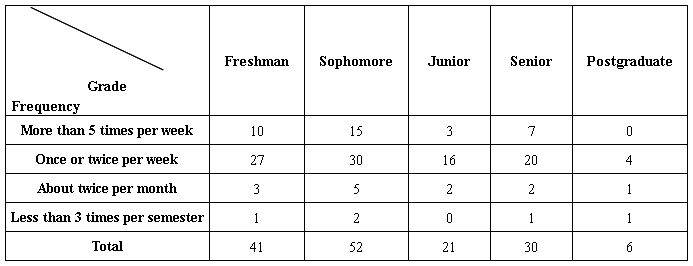
Result:
As it can be seen from Figure 1, most students go to library once or twice a week. Some students go there more than five times a week. The freshmen and junior students go to the library more frequently.
Reasons:
1) The freshmen have more spare time and they are curious about the library where they can find almost all the books and periodicals they are interested in.
2) The junior students need a lot of materials for their courses. Moreover, most of the juniors want to find some quiet places to study and the library becomes their first choice.
2.1.2 Purpose Analysis
Question 5 is designed to know the college students’ purposes of going to the school library.
Figure 2
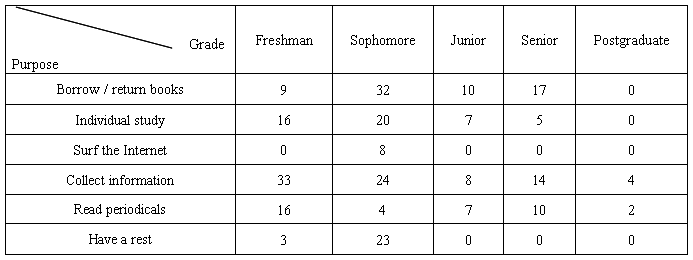
Figure3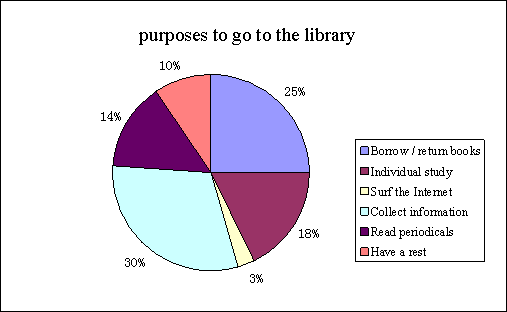
Result:
Figure 2 and 3 reveal that the sophomores and the junior students can make full use of the resources in the library. Their purposes are clear: they hope to improve themselves on all aspects. While the freshmen have less pressure, so they prefer the periodicals just for entertaining and widening their horizon. The seniors and postgraduates like to read periodicals because they want to help with homework or essay writing and know more about current affairs.
2.1.3Book Variety Analysis
Based on Question 9, we get Figure 4 below.
Figure 4
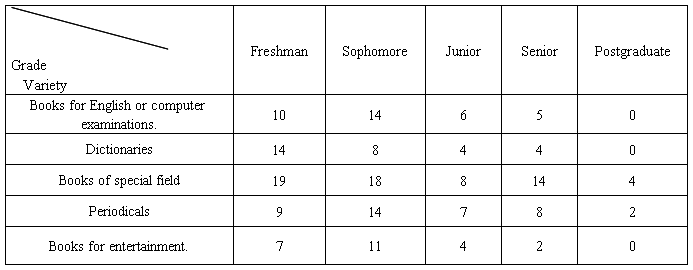
Result:
Obviously, most of the interviewees think that books of special field are most helpful. It shows that most of students in our university put study in the first place. We can also learn that other kinds of books and magazines are also very useful in most students’ eyes. However, 76.67% of the students investigated are dissatisfied with the books in our library. They complain that the books are outdated and they need to be updated.
2.1.4On Borrowing Books
According to the statistics based on Question 7 and 8, we learn that 41.33% of the students borrow less than 10 books in one semester while 7.33% borrow more than 30. 70% say that they can finish reading most parts of the borrowed books before returning them. This is a good phenomenon. Since different people have different plans for study, sometimes they don’t need to finish the whole. Instead, some parts of books are enough.
2.1.5On Facilities and Reading Rooms
In consequence of Question 6, it is known that students like to go to the natural science and social science reading room, besides periodicals and newspapers reading room. The most popular section is periodicals reading section. Students can not only expand their knowledge but also know something about arts, sports and so on. As well, they can release from the pressure in daily study.
According to our survey (Question 10), 30.67% of students can use all the functions of the data retrieval system skillfully, 42% of them are likely to use only some of the functions, while there are 27.33% who seldom use it. A research, once carried out by the former State Education Commission on students studying aboard, found that Chinese students’ low level of scientific research stemmed from their ability of referring and using information materials (especially the ability to use the data retrieval system of combined computers) (Gao & Li, 1998; Yan & Luo, 2003). So it’s very necessary to improve our ability to refer to information. We suggest college students, especially freshmen, should learn to use the data retrieval system as soon as possible.
2.2 Data Analysis on the Use of Periodicals and Newspapers
Question 12, 13, 14, 15, 16 and 17 are designed to know the general information of periodicals and newspapers section.
2.2.1 Frequency and Purpose Analysis
Figure 5 shows how often the respondents read periodicals and newspapers.
Figure 5
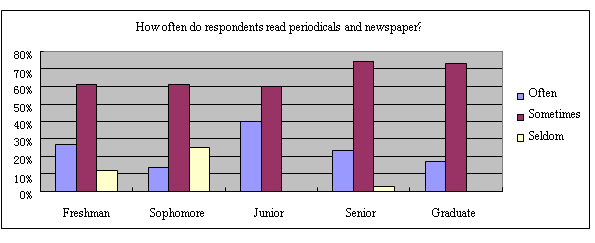 Result:
Result:
Figure 5 demonstrates that from freshmen to graduates, most of them read periodicals and newspapers regularly about 2 or 3 times per week. Only a few freshmen and sophomores never or seldom read periodicals and newspapers.
The cylindrical Figure 6 below tells us the purposes for respondents to read periodicals and newspapers.
Figure 6
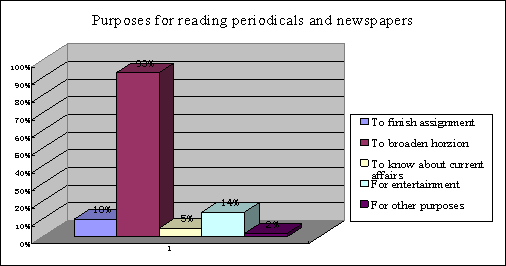
Result:
It shows that the purpose for finishing assignment takes 10%, for broadening horizon takes 93%, and for entertainment takes 14%. It is obvious that broadening horizon is the main purpose for students to go to the forth floor to read periodicals and newspapers, because school library is the most important place to acquire knowledge and collect information. However, what attracts our attention is entertainment occupies the second place for students to use advanced equipment in the library.
Reasons:
From Figure 5 and 6 above:
1) The library’s opening time conflicts with student’s class time. And college students in our campus can’t balance their time well, so the chances for students to enter the library are limited.
2) Students can’t borrow the periodicals and newspaper from the school library.
3) There is little recourse about science, humanity, literature in college student’s hands. They have no other choices.
4) Freshmen who have less lectures and more spare time, and seniors who are under great pressure prefer to read some periodicals and newspaper for entertainment.
2.2.2 On the Outdated Periodicals and Newspapers
The following two figures show the use of periodicals and newspapers in our library
Figure 7

Figure 8
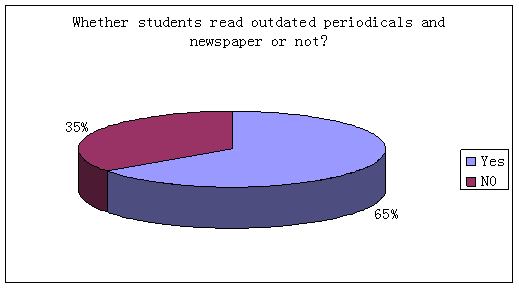
Result:
Figure 7 obviously shows that 71% respondents take notes when they read periodicals and newspapers. It is nearly 2 times of the respondents who don’t take notes while reading. Figure 8 shows that 65% of the students who take part in our investigation have the experience of reading the outdated periodicals and newspapers. While 35% of them never read any outdated periodicals or newspapers.
Reasons:
1) Due to the fact that the periodicals and newspapers can only be read in the library, the students who want to collect information or digest some details have to take notes.
2) The students who don’t take notes result from their consideration that taking notes is a waste of time.
3) The reason for most students having the habit of reading outdated periodicals and newspapers is that the number of the latest ones is limited.
4) The students who focus on latest periodicals and newspapers maintain that the outdated ones are worthless.
Suggestions:
1) Extend the opening time. For instance, open the library the whole day from 7:00 a.m~10:00 p.m.
2) Allow the students to borrow the periodicals and newspapers, whatever the outdated or the latest.
3) Introduce more useful and interesting periodicals and newspapers and enlarge the quantities.
2.3 Data Analysis on the Use of Electronic Resources
Questions 18, 19, 20 and 21 provide basis for this analysis.
The electronic resources are an important part in our university library, because of which, it is involved in the investigation.
Figure 9
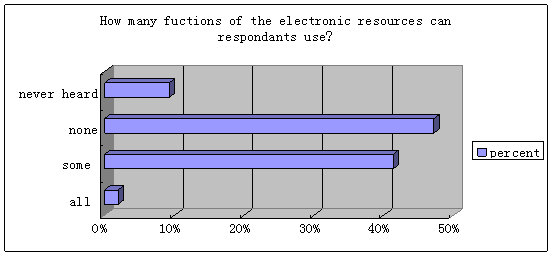
From the above figure, we can know that most of them can just use some of the functions. Most students who are familiar with the electronic resources are senior students and postgraduates. In addition, more than half of the interviewees just heard of it, but never used it.
The majority users converge in senior students and graduate students, while lower grades know little about electronic resources. Their purpose is mainly on searching some information from both China and abroad. In their opinion, the electronic resources are in great value and very helpful for them.
Reasons:
1) Students, especially freshmen, are not so familiar with the electronic resources.
2) The computers are not enough for students to look for information in the electronic resources area.
Suggestions:
1) The library should give some lectures on how to use the electronic resources so that students can be more familiar with it.
2) Increase the number of computers in school library and allow students to use computers in the reading rooms.
2.4 Data Analysis on the Use of Individual-study Area
The analysis, focused on the use of individual-study area, has its base on Question 22 and 23.
According to our survey, 13.3% of the interviewees said that they always go to the library for individual study, while 57.3% sometimes do the individual study. Another 6% have never been there for individual study.
Nearly half of the interviewees think the environment of our school library is just in an average level, while 40% of them consider it good. As for interviewees who want to go further study, they hold the opinion that the environment in individual-study area is not good enough.
From the survey, we can see that most of the respondents are willing to study in individual-study area. However, they are not very satisfied with the environment.
The individual-study area is one of the important hardware facilities. The seats there are not enough and they are always occupied by some students who don’t obey the rules of library. Their action leads to the result that students can’t make the most use of the individual-study area. That’s unfair for those well-disciplined readers. On the other hand, the attitude of the librarians is not good enough. Sometimes they treat students in rude ways.
3. Conclusions
Through the whole survey, we find a good phenomenon that most students in our university have the desire to take advantage of the resources provided in school library, especially the references in their own major. Most students’ purpose to go to the library is to look for the materials that help them in their own field. What’s more, we are glad to find that most people can finish reading the majority of the books they borrowed. In addition, students participated prefer to read periodicals and newspapers so that they can broaden their horizon and enjoy themselves. Most of them are willing to read outdated periodicals and newspapers. From this point, we learn that their craving for knowledge is strong.
However, we still find some problems facing college students, there are three main problems as follows.
First, most students don’t know how to use data retrieval system. As a result, they have to waste a lot of time on looking for a certain book shelf by shelf.
Second,students seldom use the electronic resources. What’s worse, some students, especially undergraduate students, even don’t know there are electronic resources in our school library. As a result, they ignore a huge treasure-house of knowledge and information.
Third, many students complain that the books in school library are outdated and can’t meet their needs. In addition, our school library is lack of some files leading the academic research in some field. Aimed at solving these problems, we give some suggestions in Part 4.
4. Suggestions
1) According to our survey, the interviewees said they did not know well about how to use the electronic resources and information searching program. So the library should give some lectures on how to properly use the data retrieval system so that the students can hold “the key of the treasury-house about knowledge” (Cui, 2004). The librarians can use blackboards and Internet to give the bulletin to students. In addition, they can make some speeches about how to use the equipments in library to help us students master the methods of taking advantage of recourses in the library.
2) Though the library has spent a huge amount of money building four electronic libraries for readers, many students still know little about them due to the lack of dissemination. School library didn’t mention how to take advantage of them. That is a waste of resources and money. The well-used network provides a convenient way to teach and learn, so digital resources will play a more and more important role in our study. That requires us to be conscious of the significance of information and importance of our digital resources.
3) The students should work hard and learn as much as possible during the college life and have initiative to seek more skills and knowledge. We can help each other to know more about how to use the resources in library and share what we have gained from study.
4) The librarians can invite some excellent professional teachers to give some lectures which meet the students’ needs in order to improve our students’ self-study ability.
5) Some of the books stored in library are out of date and the range of them are too limited, so the students who participated in the survey hope that our school library can enrich the book storage, accept the suggestions raised by students, bring in some books which meet the needs of readers, and let our students know that those books are professional, abundant and fashionable. Some popular journals and subscriptions like China Daily, Readers and Times should be presented more.
6) Readjusting and prolonging the opening time, especially on weekends so that students can have enough time to return and borrow books.
7) Finally, the library should prohibit students from occupying seats in studying zone. School library should provide students with more seats in studying zone. Also, “Keep quiet” should be carried out through to the end.
5. Limitations
Our survey is limited in terms of place, which is confined only in our university. It cannot indicate the thorough conditions in all universities. So our analyses are not sweeping enough. In addition, our survey is limited in our polytechnic university. That means, 60% of the respondents are science and engineering students, and only 3.3% of the students are from the college of humanities and law. Therefore, the depth and width of the questions are limited.
Bibliography
[1] 毛峡,丁应宽.图象的情感特征分析及其和谐感评价[J].电子学报,2001,29(12A):1923-1927.
[2] 刘国钧,王连成.图书馆史研究[M].北京:高等教育出版社,1979:15-18,31.
[3] 毛峡.绘画的音乐表现[A].中国人工智能学会20##年全国学术年会论文集[C].北京:北京邮电大学出版社,2001:739-740.
[4] 张和生.地质力学系统理论[A].太原:太原理工大学,1998.
[5] 冯西桥.核反应堆压力容器的LBB分析[R].北京:清华大学核能技术设计研究院,1997.
[6]姜锡洲.一种温热外敷药制备方案[P].中国专利:881056078,1983-08-02.
[7]GB/T16159-1996,汉语拼音正词法基本规则[S].北京:中国标准出版社,1996.
[8]王名亮.中国学术期刊标准化数据库系统工程的[EB/OL]. Http//xxxxx.ndjkfmk.fbuiwa/nsbvhjiaf/ckjv/980810-2.jkncjsans,1998-08-06/1998-10-04.
Acknowledgements
(致谢,约100英文字)
Appendices
Questionnaire in English
Questionnaire in Chinese
A Questionnaire on College Students’ Use of the School Library Resources
Dear friends,
The questionnaire is designed for the purpose of investigating college students’ use of the school library resources. We would appreciate it if you can spare a few minutes to help us finish the survey. Thanks for your cooperation.
1. Your gender?
A. Male B. Female
2. Your grade?
A. Freshman B. Sophomore C. Junior D. Senior E. Postgraduate candidate
3. Which of the following does your major belong to?
A. Science and Engineering B. Economic and Management
C. Humanity and Law D. Foreign Languages E. Arts
4. How often do you go to the library?
A. More than 5 times per week. B. Once or twice per week.
C. About twice per month. D. Less than 3 times per semester. E. Seldom.
5. Why do you go to the library? (You can choose more than one of the following.)
A. Borrow or return books. B. Individual-study. C. Surf the Internet.
D. Collect information. E. Read magazines and periodicals. F. Have a rest.
6. Which reading section do you like best? (You can choose more than one of the following.)
A. 2F: Literature and Arts and History Section
B. 2F: Chinese, Foreign Language and Dictionaries Stack Room
C. 3F: Social and Natural Sciences and Technology Section
D. 4F: Newspapers and Periodicals Reading Area
F. 5F: Foreign Language Reading Room
7. How many books do you borrow from the library every semester?
A. Less than 10 (including 10). B. 11~20. C. 21~30. D. More than 31.
8. How many books (borrowed from the library) can you finish reading?
A. All of them. B. Most of them. C. Some of them. D. Few of them.
9. What books do you think benefit you most?
A. Books for English or computer examinations.
B. Dictionaries.
C. Books of special field.
D. Books for entertainment.
E. Magazines and newspapers.
10. Can you use the data retrieval system well?
A. I can use all the functions skillfully.
B. I can use only some of the functions.
C. I seldom use it.
11. Do you think the resources in school library are enough for your study?
A. Enough B. Not enough, because the resources are out of date.
12. How often do you read periodicals and newspapers?
A. Often B. Sometimes C. Seldom
13. What kind of periodicals or newspapers do you prefer?
A. Natural science. B. Social science. C. Literature.
D. Academic research. E. Entertainment. F. Others.
14. What is your purpose to read periodicals or newspapers? (It is acceptable if you choose more than one of the following.)
A. To help with homework or essay writing. B. To broaden horizon.
C. To get to know current affairs. D. For entertainment.
E. For other purposes.
15. Do you take notes when you read periodicals or newspapers?
A. Yes. B. No.
16. Have you ever read the outdated periodicals or newspaper?
A. Yes. B. No.
17. What kind of periodicals or newspapers do you prefer if they can be borrowed?
A. The outdated. B. The latest. C. Both A and B. D. Neither A or B.
18. Do you know about the electronic resources?
A. I know it well and use it very often. B. I know a little and use a little.
C. I heard about it, but never use it. D. I never heard of it
19. Which kind of electronic resources do you often use? (It is acceptable if you choose more than one of the following.)
A. Periodicals in Chinese.
B. Books in Chinese.
C. Data base in Chinese.
D. Periodicals in foreign languages.
E. Books in foreign languages
F. I never use it.
20. What is your purpose to use the electronic resources?
A. Information collection. B. Information scanning.
C. Academic study D. I never use it.
21. Do you think the electronic resources are helpful?
A. Yes. I benefit a lot. B. Just so so.
C. It can give me a little help. D. I never use it.
22. Do you often go to the library for individual-study?
A. Often. B. Sometimes. C. Seldom. D. Never.
23. How do you think of the environment of the individual-study area?
A. Very good. B. All right. C. Very bad.
24. What are your suggestions for our school library?
大学生对图书馆资源利用情况的调查问卷
亲爱的同学们,为了了解大家对学校图书馆资源的利用和使用情况,我们作了本次调查,希望您能抽出一些宝贵时间配合我们的调查,谢谢您的合作。
1.您的性别?
A.男 B.女
2.您的年级?
A.大一 B.大二 C.大三 D.大四 E.研究生
3.您的专业门类是?
A.理工类 B.经管类 C.文法类 D.外语类 E.艺术类
4.您经常去图书馆吗?
A.一周五次以上 B.一周一两次 C.两三周一次 D.一学期两三次 E.很少
5.您去图书馆的主要目的?(可多选)
A.借、还书 B.自习 C.上网 D.看书、查资料 E.看杂志、期刊 F.睡觉休息
6.您经常去以下哪些阅览室?
A.二层西区语言文字类图书阅览室
B.二层东区文学艺术类图书阅览室
C.三层自然科学与社科类图书阅览室
D.四层期刊杂志与报纸阅览室
E.五层外文资料室
7.现在平均一学期您从图书馆中借阅多少本书?
A.10本以下 B.11~20本 C.21~30本 D.30本以上
8.您在图书馆所借阅图书的阅读情况是:
A.全看 B.看大部分内容 C.看小部分内容 D.没来得及看
9.您觉得哪些图书对您帮助最大?
A.英语、计算机类考试指导 B.工具书 C.专业书 D.休闲娱乐类 E.报纸杂志类
10.您能否熟练使用图书馆的图书检索工具?
A.能熟练使用其全部功能 B.仅能使用其部分功能 C.很少使用检索工具
11.您认为图书馆馆藏资料对于自己的学科学习来说
A.足够 B.不够,资料过于陈旧,缺乏新资料
12.您经常阅读期刊杂志和报纸吗?
A.经常阅读 B.偶尔阅读 C.很少阅读
13.您主要阅读哪类期刊杂志或报纸?
A.自然科学类 B.社会科学类 C.文学类 D.学术研究类 E.娱乐休闲类 F.其他
14.您阅读期刊杂志报纸的目的是?
A.完成作业或论文 B.拓宽知识面 C.了解时政 D.休闲娱乐 E.其他
15.您在阅读期刊杂志和报纸时是否做摘要或笔记?
A.是 B.否
16.您是否会阅读过刊?
A.是 B.否
17.如果图书馆的期刊杂志和报纸可以借出,您希望借阅?
A.过刊 B.现刊 C. 过刊和现刊都想借阅 D.不想借阅,只想在阅览室阅览
18.您对图书馆电子资源的了解程度
A.非常了解,几乎每个数据库都使用过 B.用过一些
C.听说过,但没用过 D.不知道图书馆有电子资源
19.您常使用哪些类型的图书馆电子资源?(可多选)
A.中文期刊类 B.中文图书类 C.中文数据库类 D.外文期刊类 E.外文图书 F.不用
20.您使用图书馆电子资源的目的是?
A.查找资料 B.简单浏览 C.学术研究 D.未使用过
21.您认为电子资源的利用价值如何?
A.很有利用价值,帮助很大 B.利用价值一般,有帮助但不大
C.没有什么利用价值 D.从没用过,不清楚其利用价值
22.您经常去图书馆上自习吗?
A.经常去 B.偶尔去 C.很少去 D.从来不去
23.您认为图书馆自习区的自习环境如何?
A.环境很好 B.环境一般 C.环境很差,很乱
24.您对图书馆有何建议?
-
调查报告范文2 (英文)
1IntroductionLibraryisalwaysasymboloftheuniversityItprovidescollegestudents…
-
英语调查报告范文
英语调查报告范文英语gt调查报告gt范文一目前高等学校在职业教育方面存在着一些突出问题学校教育与学生就业及市场对人才的需求相脱节教…
-
英语基础写作-调查报告类型
基础写作---调查报告一:题型说明调查报告是针对某一现象、某一事件或某一问题进行深入细致的调查的写作题,要求同学们根据调查结果,针…
-
英文版调查报告_survey
ASurveyAboutThePatrioticEmotionOfUniversityStudentsNowadaysChinaisdevelopin…
-
商务英语专业社会调查报告范文
作为外国语学院商务英语专业的学生,当然,我必须发挥自己在专业上的长处。虽然,才刚进入大一,没有对专业的商务英语进行学习,但是也尝试…
-
英语基础写作-调查报告类型
基础写作---调查报告一:题型说明调查报告是针对某一现象、某一事件或某一问题进行深入细致的调查的写作题,要求同学们根据调查结果,针…
-
服装市场调查报告 英文
MarketingResearch1.ResearchPurpose:Now,moreandmorepeoplepayattent…
-
英语研究性学习结题报告范文
本次的实践活动我们班完成的十分好。我们在看英文电影的时候,不仅看到了精美的画面,同时也学到了不少。我认为看英文电影可以补充中国没有…
-
商务英语专业社会调查报告范文
作为外国语学院商务英语专业的学生,当然,我必须发挥自己在专业上的长处。虽然,才刚进入大一,没有对专业的商务英语进行学习,但是也尝试…
-
英文工作报告范文
英文工作报告范文Direction:Takeareportbytheacademicdepartmentofanassociati…
-
一、调查报告格式和要求
调查报告格式要求一、调查报告撰写的内容与要求:一份完整的调查报告应由以下部分组成:-1.报告题目-报告题目应该用简短、明确的文字写…